Bellacord Hall
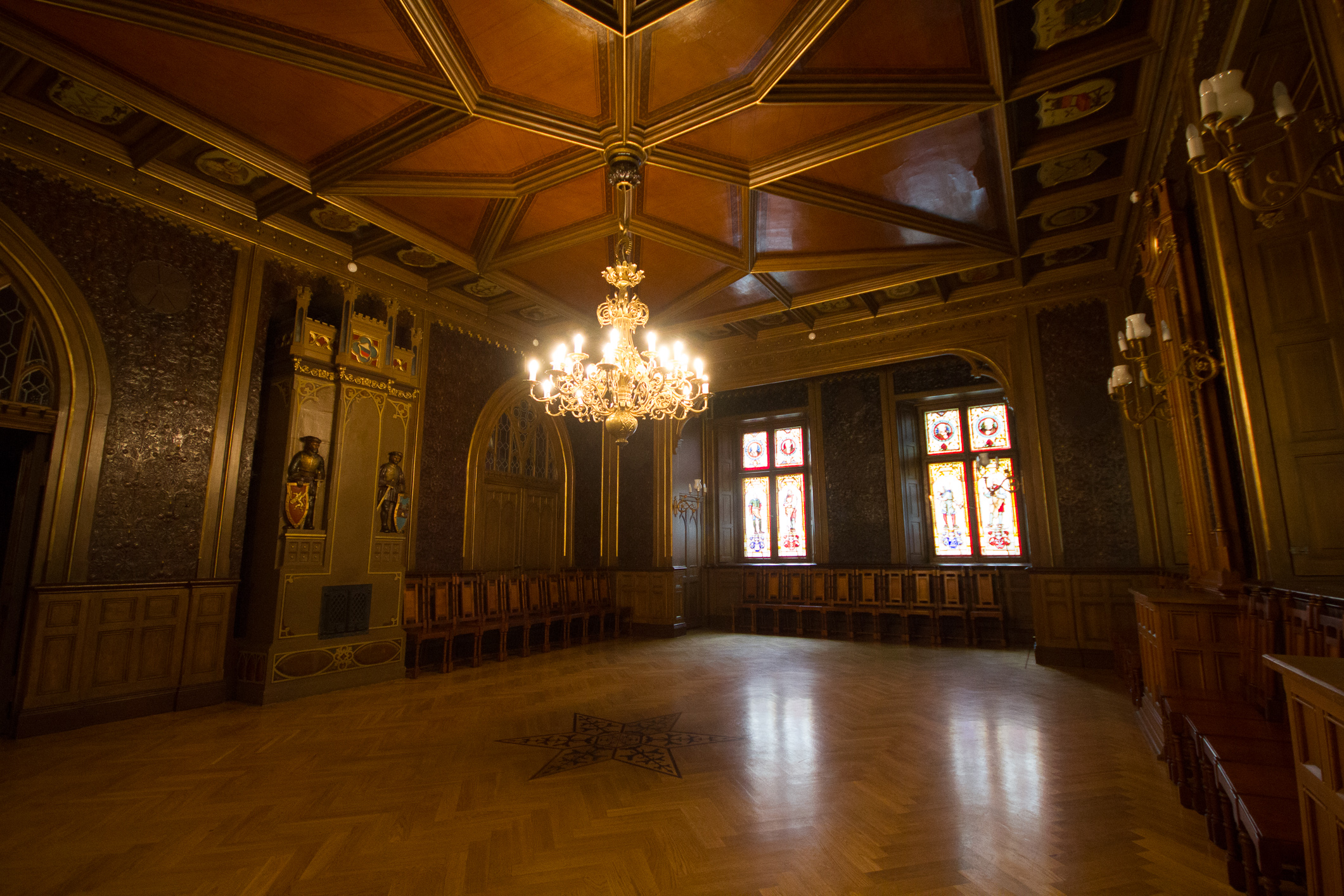
The ceiling of the senior meeting hall was painted with wax paint and gilded in 1888 (painter V. Harmsen). The coats of arms of 34 fraternities of trade and crafts are painted on metal shields and located in the plane of the ceiling.
For each of the fraternities its year of foundation is mentioned, but for some also the year until which they existed. A multi-branched brass chandelier made in 1854 is in the center of the ceiling.
All of the original wooden decorations of 1888 have been preserved – panels, pilasters, ceiling profiles, shutters and between the windows – two pseudo-Gothic mirrors, on the walls – lincrusta wallpaper made in 1888.
In the central part of the parquet floor a star made in the inlay technique can be observed, but next to the wall – a tile stove in neo-Gothic shape with two figures holding shields with the coats of arms of Vidzeme and Riga.
All five of the hall windows contain stained glass made by A. A. Freystadtl’s workshop (Atelier) in Hanover in 1888.
At the top of the stained glass windows, ten portraits of the benefactors of the Small Guild are placed in medallions. And next to the medallions the name of the benefactor and information about the nature of his gift can be read.
The lower sash of the window shows full-length portraits of the elders of ten construction-related fraternities, with the appropriate trade emblem and the surnames of the elders in German below.
Stairs
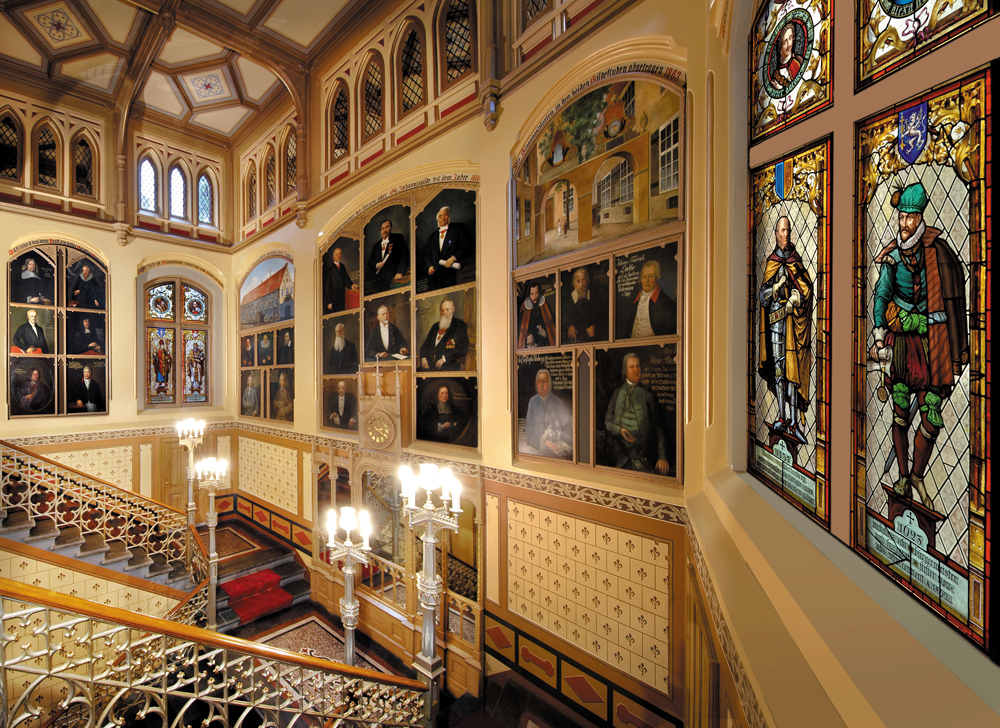
The staircase housed historical paintings with views of the old building and the Sand Gate, as well as portraits of guild eltermans. After the liquidation of the guild, these paintings were handed over to the Museum of the History of Riga and Navigation. Under the care of Lilita Laina, the director of the Riga Culture and Folk Art Center “Small Guild”, copies of these paintings were made and the blanks were filled. In cooperation with the already mentioned museum, an opportunity was found to deposit the original stained glass windows created for the whole building in the Small Guild.
Large hall
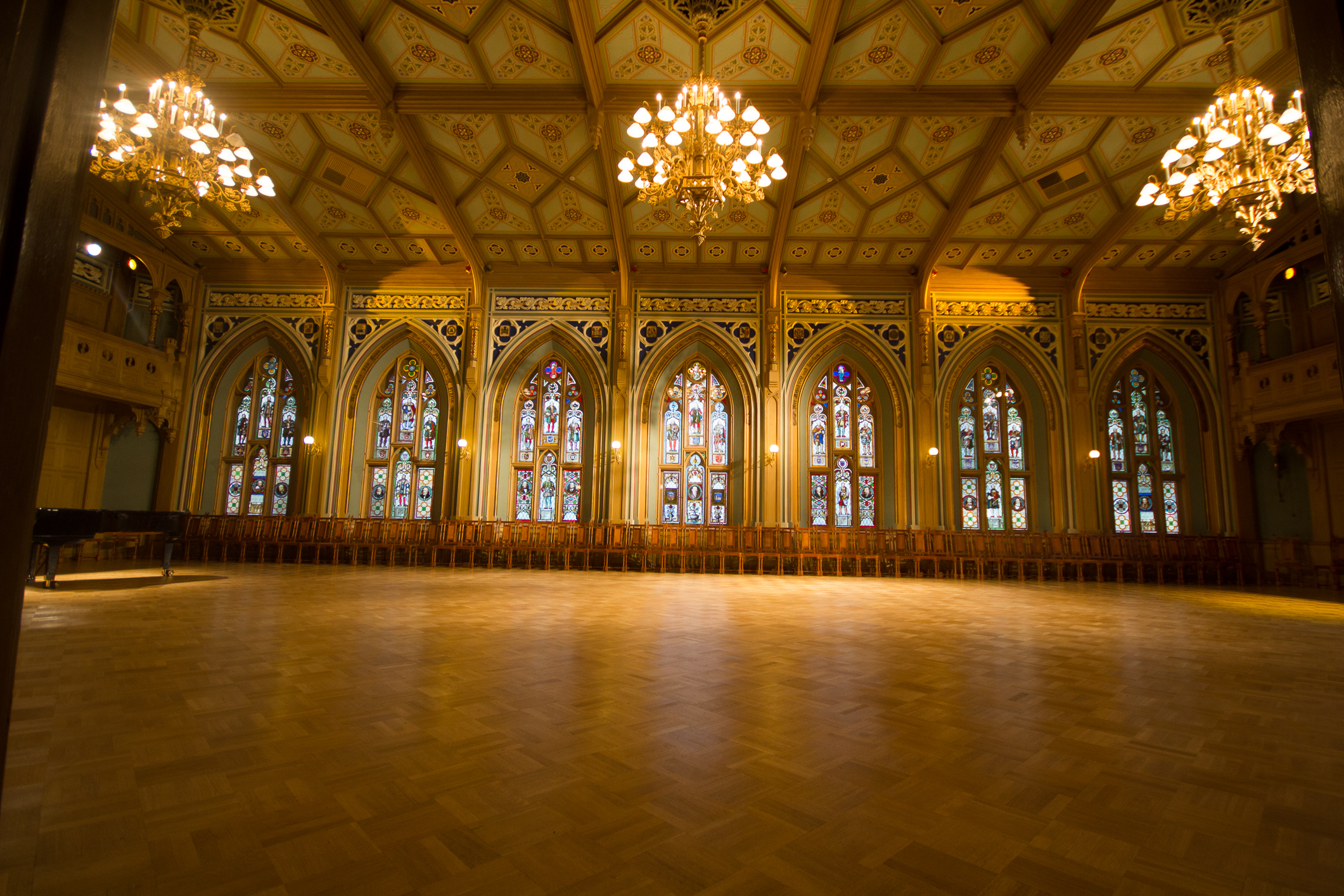
Gothic forms are used in the interior of the large hall (and the meeting halls).
The hall is richly decorated with neo-Gothic pilasters, wooden panels, painted ceilings, stained glass and paintings.
The hall has seven doorways and seven window sills. At the top of the walls are the coats of arms of various crafts, in the space above the doors – painted city panoramas (Lübeck, Bremen, St. Petersburg, Riga, Moscow, Hamburg and Rostock).
The room is illuminated by three crown chandeliers. The stained glass windows of the Great Hall, as seen today, were made in the workshop of A. A. Freystadtl in Hanover and placed in the windows of the Small Guild in 1888.
The portrait of the artist is placed in the stained glass window of the adjoining room.
There is also a stained glass portrait of Johann Daniel Felsko, the architect of the Small Guild house.
In the stained glass windows of the Great Hall, the principal place is given to the full-length portraits of the elders of 25 fraternities of different trades, in traditional costumes with appropriate emblems.
In addition, the stained glass windows housed nine stained glass portrait medallions of the benefactors of the Small Guild who had donated funds and established various charitable institutions – orphanages, shelters for widows and the disabled, benefit funds.
The sharp-bow edges of the hall’s door and window openings are adorned with painted instructive aphorisms. For example: “Whoever does good to his enemy shows the highest gallantry,” “Where work keeps the house safe, poverty does not enter.”
The large hall has windows, doors, balconies, wooden parts of the ceiling, wall panels and shutters, preserved from 1888.
As a result of the restoration of the house, there is an opportunity to go out on to a beautiful outdoor balcony overlooking Livu Square and the front garden of the Small Guild with a metal fence, the drawing of which was reconstructed after the Guild images from 2nd part of 19th century.
The Hanseatic League began to form in the middle of the 14th century. The Hanseatic League was a medieval German merchants’ organization that gradually expanded into an international political union of about 300 cities from the Baltic and North Sea basins.
Its aim was to ensure the protection of mutual interests and to promote overseas trade in Northern Europe.
Eight Latvian cities of that time were part of the Hanseatic League, and Riga was one of the main Hanseatic cities.
The regular meetings of this union were called the “Hanseatic Days”.
The Riga Culture and Folk Art Center “Small Guild” has a very close connection with the former Hanseatic League – paintings and coats of arms of the Hanseatic cities can be seen both in the lobby and in the halls.
The Hanseatic Days are actively celebrated not only in Riga, but also in other cities of the Hanseatic League.
Small Hall
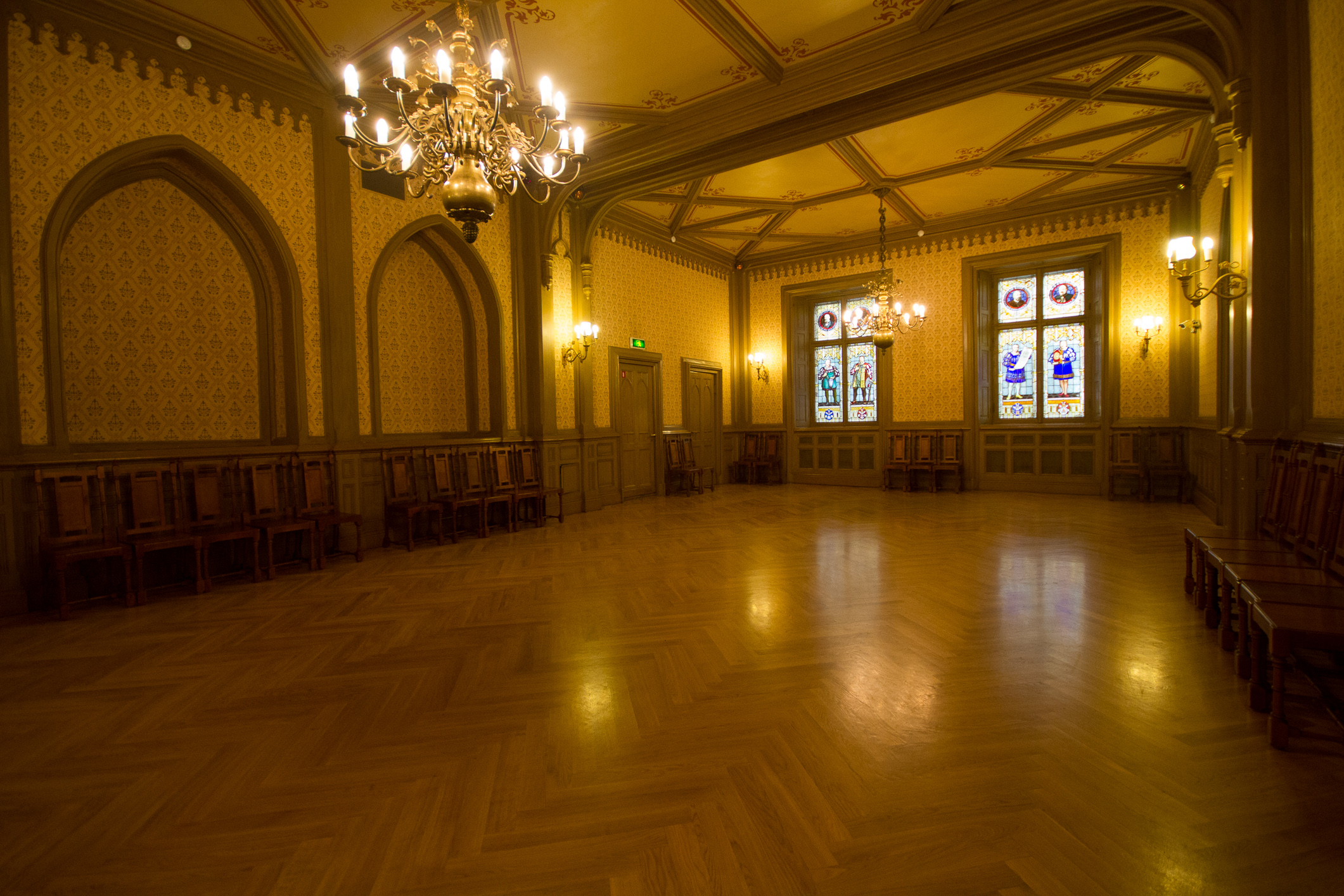
To the right of the lobby is the small hall. The different craft associations usually held their meetings in this hall, and it was also the place where the disciples, after passing the test, were transferred to the next rank, the journeyman.
In this hall, tables were set during the festivities, and therefore it was also called the dining room. In the small hall there are three brass crown chandeliers: in the middle of the hall – a gift from blacksmiths from 1735; on the right side against the entrance door, a gift from tailors from 1747; on the left in the depths of the hall a gift from the coopers from 1777.
The names of the donors are engraved on all of the crown chandeliers.
The windows also consisted of stained glass with the coats of arms of various trades, some of which were still preserved from the old house.
After a long search, they were found in the collection of the Museum of the History of Riga and Navigation, and now the stained glass windows originally designed for the Small Guild can be seen throughout the building.
Lobby
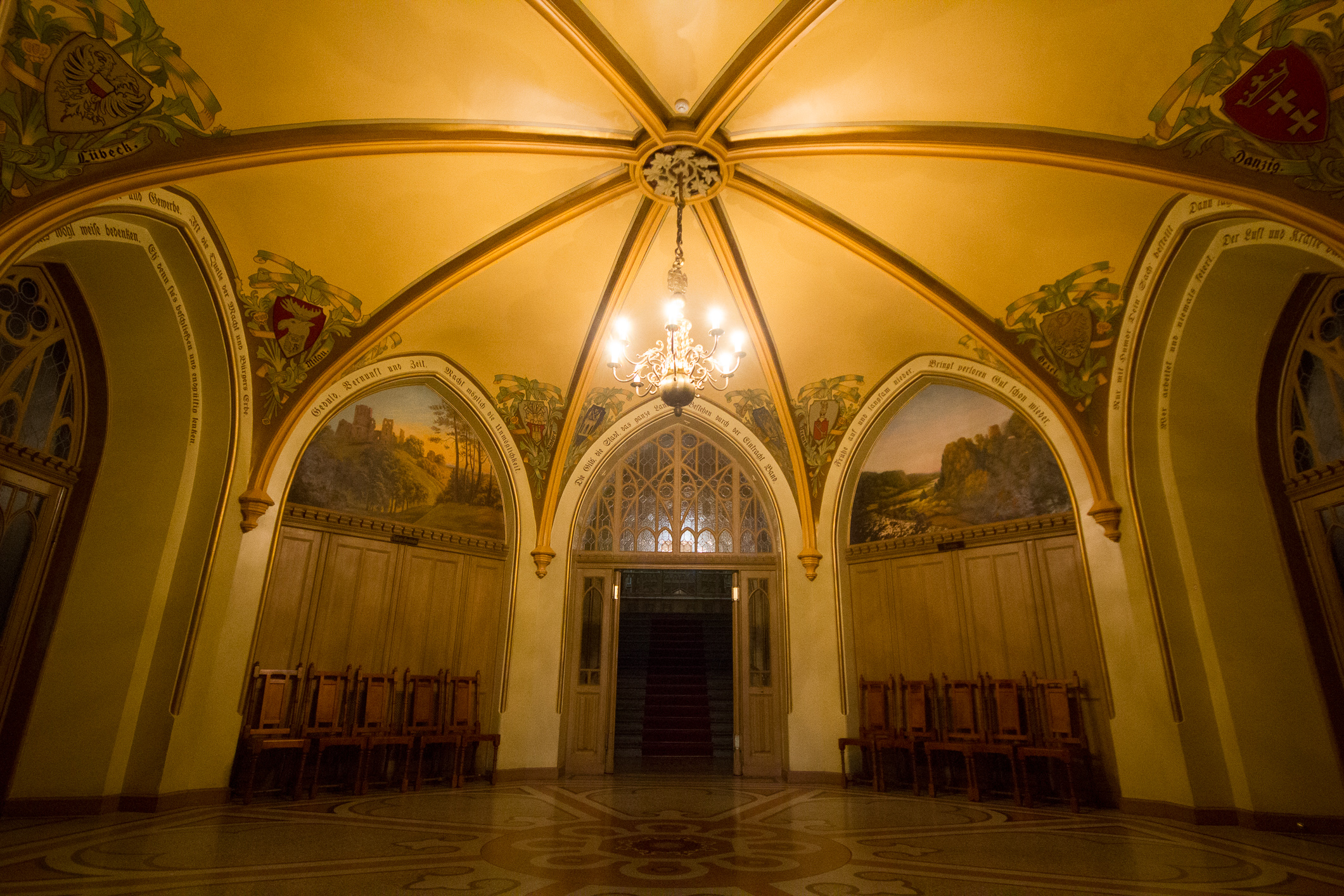
In the plan the lobby of the house is shaped as a regular octagon. Luxurious, glazed doors with skylight windows have been created in the four walls of the room.
The other four walls above the wooden panels reveal the painted landscapes of the four Vidzeme castle ruins from tsarist times (Vastselina, Turaida, Koknese and Cesis).
In the center of the room there is an eight-branch brass chandelier made in 1775. Intricate vignettes with the coats of arms of 16 cities have been restored on the ceiling.
Both the lobby and the staircase have teracco floors, made in 1888 by Italian masters from Johor Odorico in Frankfurt am Main.
An interesting detail of the interior decoration are the ancient German aphorisms, expressions and “grains of thought” in Gothic font and saturated with ancient German terms, located in practically all of the rooms.
These inscriptions serve as a unifying component of interior decor, as an ornament with artistic value, similarily to Arabic script, which only a few can read.
Bellacord Hall

The ceiling of the senior meeting hall was painted with wax paint and gilded in 1888 (painter V. Harmsen). The coats of arms of 34 fraternities of trade and crafts are painted on metal shields and located in the plane of the ceiling.
For each of the fraternities its year of foundation is mentioned, but for some also the year until which they existed. A multi-branched brass chandelier made in 1854 is in the center of the ceiling.
All of the original wooden decorations of 1888 have been preserved – panels, pilasters, ceiling profiles, shutters and between the windows – two pseudo-Gothic mirrors, on the walls – lincrusta wallpaper made in 1888.
In the central part of the parquet floor a star made in the inlay technique can be observed, but next to the wall – a tile stove in neo-Gothic shape with two figures holding shields with the coats of arms of Vidzeme and Riga.
All five of the hall windows contain stained glass made by A. A. Freystadtl’s workshop (Atelier) in Hanover in 1888.
At the top of the stained glass windows, ten portraits of the benefactors of the Small Guild are placed in medallions. And next to the medallions the name of the benefactor and information about the nature of his gift can be read.
The lower sash of the window shows full-length portraits of the elders of ten construction-related fraternities, with the appropriate trade emblem and the surnames of the elders in German below.
Stairs
 The staircase housed historical paintings with views of the old building and the Sand Gate, as well as portraits of guild eltermans. After the liquidation of the guild, these paintings were handed over to the Museum of the History of Riga and Navigation. Under the care of Lilita Laina, the director of the Riga Culture and Folk Art Center “Small Guild”, copies of these paintings were made and the blanks were filled. In cooperation with the already mentioned museum, an opportunity was found to deposit the original stained glass windows created for the whole building in the Small Guild.
The staircase housed historical paintings with views of the old building and the Sand Gate, as well as portraits of guild eltermans. After the liquidation of the guild, these paintings were handed over to the Museum of the History of Riga and Navigation. Under the care of Lilita Laina, the director of the Riga Culture and Folk Art Center “Small Guild”, copies of these paintings were made and the blanks were filled. In cooperation with the already mentioned museum, an opportunity was found to deposit the original stained glass windows created for the whole building in the Small Guild.
Grand Hall

Gothic forms are used in the interior of the large hall (and the meeting halls).
The hall is richly decorated with neo-Gothic pilasters, wooden panels, painted ceilings, stained glass and paintings.
The hall has seven doorways and seven window sills. At the top of the walls are the coats of arms of various crafts, in the space above the doors – painted city panoramas (Lübeck, Bremen, St. Petersburg, Riga, Moscow, Hamburg and Rostock).
The room is illuminated by three crown chandeliers. The stained glass windows of the Great Hall, as seen today, were made in the workshop of A. A. Freystadtl in Hanover and placed in the windows of the Small Guild in 1888.
The portrait of the artist is placed in the stained glass window of the adjoining room.
There is also a stained glass portrait of Johann Daniel Felsko, the architect of the Small Guild house.
In the stained glass windows of the Great Hall, the principal place is given to the full-length portraits of the elders of 25 fraternities of different trades, in traditional costumes with appropriate emblems.
In addition, the stained glass windows housed nine stained glass portrait medallions of the benefactors of the Small Guild who had donated funds and established various charitable institutions – orphanages, shelters for widows and the disabled, benefit funds.
The sharp-bow edges of the hall’s door and window openings are adorned with painted instructive aphorisms. For example: “Whoever does good to his enemy shows the highest gallantry,” “Where work keeps the house safe, poverty does not enter.”
The large hall has windows, doors, balconies, wooden parts of the ceiling, wall panels and shutters, preserved from 1888.
As a result of the restoration of the house, there is an opportunity to go out on to a beautiful outdoor balcony overlooking Livu Square and the front garden of the Small Guild with a metal fence, the drawing of which was reconstructed after the Guild images from 2nd part of 19th century.
The Hanseatic League began to form in the middle of the 14th century. The Hanseatic League was a medieval German merchants’ organization that gradually expanded into an international political union of about 300 cities from the Baltic and North Sea basins.
Its aim was to ensure the protection of mutual interests and to promote overseas trade in Northern Europe.
Eight Latvian cities of that time were part of the Hanseatic League, and Riga was one of the main Hanseatic cities.
The regular meetings of this union were called the “Hanseatic Days”.
The Riga Culture and Folk Art Center “Small Guild” has a very close connection with the former Hanseatic League – paintings and coats of arms of the Hanseatic cities can be seen both in the lobby and in the halls.
The Hanseatic Days are actively celebrated not only in Riga, but also in other cities of the Hanseatic League.
Small Hall
 To the right of the lobby is the small hall. The different craft associations usually held their meetings in this hall, and it was also the place where the disciples, after passing the test, were transferred to the next rank, the journeyman.
To the right of the lobby is the small hall. The different craft associations usually held their meetings in this hall, and it was also the place where the disciples, after passing the test, were transferred to the next rank, the journeyman.
In this hall, tables were set during the festivities, and therefore it was also called the dining room. In the small hall there are three brass crown chandeliers: in the middle of the hall – a gift from blacksmiths from 1735; on the right side against the entrance door, a gift from tailors from 1747; on the left in the depths of the hall a gift from the coopers from 1777.
The names of the donors are engraved on all of the crown chandeliers.
The windows also consisted of stained glass with the coats of arms of various trades, some of which were still preserved from the old house.
After a long search, they were found in the collection of the Museum of the History of Riga and Navigation, and now the stained glass windows originally designed for the Small Guild can be seen throughout the building.
Lobby

In the plan the lobby of the house is shaped as a regular octagon. Luxurious, glazed doors with skylight windows have been created in the four walls of the room.
The other four walls above the wooden panels reveal the painted landscapes of the four Vidzeme castle ruins from tsarist times (Vastselina, Turaida, Koknese and Cesis).
In the center of the room there is an eight-branch brass chandelier made in 1775. Intricate vignettes with the coats of arms of 16 cities have been restored on the ceiling.
Both the lobby and the staircase have teracco floors, made in 1888 by Italian masters from Johor Odorico in Frankfurt am Main.
An interesting detail of the interior decoration are the ancient German aphorisms, expressions and “grains of thought” in Gothic font and saturated with ancient German terms, located in practically all of the rooms.
These inscriptions serve as a unifying component of interior decor, as an ornament with artistic value, similarily to Arabic script, which only a few can read.

